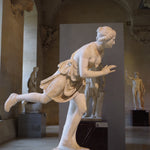Global Antiques and Fine Art
Authentic 2nd Century CE Gandharan Graeco-Bactrian Schist Relief 20.1 inches w/ 2 scenes the life of Buddha -w/ Certificate of authenticity
Regular price
$3,700.00 USD
Regular price
Sale price
$3,700.00 USD
Unit price
per
Couldn't load pickup availability
Authentic Gandharan Graeco-Bactrian Schist relief carved in high relief with two scenes divided by framed classical columns dating circa 2nd to 3rd century CE (AD). Long beautiful grey schist panel depicting narrative panel of Greek influence on Buddhist art. In the first scene, a figure on horseback bursts through a doorway on the right clobbering a small figure under the hooves of his steed and seemingly shocking two characters dressed in robes, one holding an object and the other speaking to the mounted figure. The second scene shows a male and female in a lavishly carved bed - the male laying with his head propped up and the female sitting facing the male, flanked by two men, perhaps guards, in contrapposto, one with a shield and the other with a spear. Realistically carved and likely depicting a scene from the life of Buddha, this relief is an excellent example of the remaining Greek influence on Buddhist art from the Graeco-Bactrian rule.
Size: 20.1" W x 4.6" H (51.05 cm x 11.68 cm)
21.1" W x 6.5" H (53.59 cm x 16.51 cm) on included custom stand.
Condition: A fragment of a larger stone carving. One large and several small pieces on the left side have been reattached, but form is still clear. Some nicks and chips to relief. Lovely earthen deposits throughout.
Provenance: Comes with Certificate of Authenticity from Artemis Gallery, prior: private East Coast collection, New York, USA; ex-East Coast collection, New York Gallery, New York City, New York, USA, acquired before 2010
The Gandharan Empire made itself wealthy in part by controlling lucrative trade along the mountain passes between China in the East and the Near East and Mediterranean in the West; a great deal of this wealth went into local patronage of artisans and art. In the first century CE, Buddhism became fashionable amongst Gandharan elites, and the art produced at this time depicting the Buddha are some of the most striking Buddhist images from the past. Their artistic tradition also reflects the conquest of Alexander the Great and the introduction of styles from all sides, blended into a uniquely Gandharan tradition, which this Buddha exemplifies. Alexander the Great conquered Gandhara in 330 BCE and with the help of the Indo-Greek kings introduced classical traditions that would influence Gandharan art for the following seven centuries.
The Bactrian Kingdom, known to historians as the Greco-Bactrian Kingdom or simply Greco-Bactria, was a Hellenistic-era Greek state and along with the Indo-Greek Kingdom, the easternmost part of the Hellenistic world in Central Asia and the Indian Subcontinent from its founding in 256 BC by Diodotus I Soter to its fall c. 120–100 BC under the reign of Heliocles II. It covered much of present-day Afghanistan, Uzbekistan, Tajikistan and Turkmenistan, and at its zenith, parts of Iran, Pakistan. Bactria was ruled by the Diodotid dynasty and rival Euthydemid dynasty. The capitals of Ai-Khanum and Bactra were among the largest and richest of antiquity - Bactria itself was known as the ‘land of a thousand golden cities’. The Indo-Greek Kingdoms, as Bactrian successor states, would last until 10 AD.
Size: 20.1" W x 4.6" H (51.05 cm x 11.68 cm)
21.1" W x 6.5" H (53.59 cm x 16.51 cm) on included custom stand.
Condition: A fragment of a larger stone carving. One large and several small pieces on the left side have been reattached, but form is still clear. Some nicks and chips to relief. Lovely earthen deposits throughout.
Provenance: Comes with Certificate of Authenticity from Artemis Gallery, prior: private East Coast collection, New York, USA; ex-East Coast collection, New York Gallery, New York City, New York, USA, acquired before 2010
The Gandharan Empire made itself wealthy in part by controlling lucrative trade along the mountain passes between China in the East and the Near East and Mediterranean in the West; a great deal of this wealth went into local patronage of artisans and art. In the first century CE, Buddhism became fashionable amongst Gandharan elites, and the art produced at this time depicting the Buddha are some of the most striking Buddhist images from the past. Their artistic tradition also reflects the conquest of Alexander the Great and the introduction of styles from all sides, blended into a uniquely Gandharan tradition, which this Buddha exemplifies. Alexander the Great conquered Gandhara in 330 BCE and with the help of the Indo-Greek kings introduced classical traditions that would influence Gandharan art for the following seven centuries.
The Bactrian Kingdom, known to historians as the Greco-Bactrian Kingdom or simply Greco-Bactria, was a Hellenistic-era Greek state and along with the Indo-Greek Kingdom, the easternmost part of the Hellenistic world in Central Asia and the Indian Subcontinent from its founding in 256 BC by Diodotus I Soter to its fall c. 120–100 BC under the reign of Heliocles II. It covered much of present-day Afghanistan, Uzbekistan, Tajikistan and Turkmenistan, and at its zenith, parts of Iran, Pakistan. Bactria was ruled by the Diodotid dynasty and rival Euthydemid dynasty. The capitals of Ai-Khanum and Bactra were among the largest and richest of antiquity - Bactria itself was known as the ‘land of a thousand golden cities’. The Indo-Greek Kingdoms, as Bactrian successor states, would last until 10 AD.


















